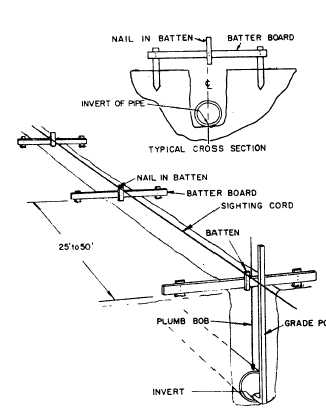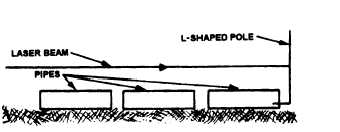Laser Method of Laying Pipe
Figure 10-20.—Setting sewer line to grade.
subtract the specified cut from 10 feet. At station 8 +
50, for example, the height of the top of the batter board
above the top of the hub would be 10 – 5.55, or
4.45 feet.
The offset is measured off from a point directly
above the hub along the batter board; a mark here is
directly over the center of the pipeline. Battens are
nailed on the batter board to indicate sewer center-line
alignment. A string is stretched and tacked along
these battens; this string indicates the horizontal loca-
tion of the line and follows the gradient of the line, but
at a distance of 10 feet above the invert. The amount
of cut required to be taken out at any point along the
line can be determined by setting a measuring pole
alongside the string. If the string indicates 8.5 feet, for
example, another 1.5 feet of cut must be taken out.
Corners of rectangular manhole boxes are staked
out much as building corners are staked out. For a box
located where a line changes direction, it may be desired
that the center line of the box bisect the angle between
the lines. The box for a curb inlet must be exactly
located with respect to a street curb to be constructed in
the future; therefore, curb inlets are usually staked out
with reference to the street plan, rather than with refer-
ence to the sewer plan.
Another useful device for controlling pipeline
excavations and laying pipe is the laser. So many
applications are being found for the laser that it may
eventually be the only tool needed for the layout and
control of construction projects. It can be quickly,
accurately, and economically used for purposes such
as distance measurement, alignment for tunnel
borings, setting of pipes with desired grades, and
setting of line and grade for many types of
construction.
The laser is an intense light beam that can be
concentrated into a narrow ray, containing only one
color (red) or wavelength of light. The resulting beam
can be projected for short or long distances and is
clearly visible as an illuminated spot on a target. It is
not disturbed by wind or rain, but it will not penetrate
fog. A laser can be set up on a bracket or even attached
to a transit telescope. The beam is aligned in the proper
direction at the desired grade and can be left relatively
unattended.
Today, instead of using batter boards and strings,
lasers can be used to control the alignment for excavat-
ing trench and setting a pipe. The laser can be set so that
it shines on the boom of a backhoe so that the equipment
operator can clearly see the illuminated spot. By its
position, the operator can closely control the depth of
digging. For laying the pipe, the laser is set in the proper
direction at the desired distance above the pipe invert.
With the aid of the L-shaped pole or templet, as shown
in figure 10-21, the workmen can control the invert
elevation. It may also be possible to direct the laser
beam from the inside of manholes through the pipes
being laid and to control the grade without any interfer-
ence from the backill operations. This can be done even
if the pipes are too small for human access.
Underground Duct System Layout
The stakeout for an underground power line is
similar to that for a sewer. For the ducts, cuts are
Figure 10-21.—Pipe laying with a laser.
10-21



